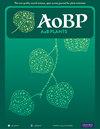根据生理和形态方式确定耐盐胁迫的番茄基因型
IF 2.4
3区 生物学
Q2 ECOLOGY
引用次数: 0
摘要
番茄(Solanum lycopersicum L.)是一种一年生蔬菜,在世界各地均有种植。在干旱和半干旱地区,它面临着生物和非生物胁迫,如盐度。研究胁迫条件下生理性状和经济性状(如果实产量)之间的关系,对于确定耐受性基因型非常必要。本研究根据几个重要的生理、形态和表观性状之间的关系,对耐受性番茄品系进行了鉴定。2019 年,根据随机完全区组设计,在三次重复的因子实验中培育了 20 个 S3 家系(因子 1:家系,因子 2:正常条件和盐度胁迫)。研究了 20 个生理、农艺和果实品质相关性状。利用方差分析证明了现有的有效遗传多样性。遗传多样性和性状之间的关系通过热图聚类以图形显示。最后,利用皮尔逊相关性、性状稳定指数和遗传率等遗传参数,采用修正的分析层次过程计算了家系的数学价值。在正常和压力条件下,家系表现出不同的行为。耐盐家系对盐胁迫有生理反应。因此,它们通过增加脯氨酸、番茄红素、类胡萝卜素和糖的含量,减少了细胞膜降解和光合作用破坏。因此,在这些品系中观察到的形态性状减少较少。根据选择策略,最重要的性状是番茄红素含量、K+/Na+比率、开花天数和生物产量。此外,H4/T/30/1、H1/T/12/5 和 H1/T/47/4 这三个家系被选为最适合构建下一代育种群体的备选家系。本文章由计算机程序翻译,如有差异,请以英文原文为准。
Determining tolerant tomato genotypes to salt stress according to physiological and morphological manner
The tomato (Solanum lycopersicum L.) is an annual vegetable cultivated all over the world. It faces biotic and abiotic stresses, such as salinity, in arid and semiarid regions. Investigating the relationship between physiological and economic traits, such as fruit yield, under stress conditions is necessary to identify tolerant genotypes. This study was conducted to identify tolerant tomato families according to the relationship between several important physiological, morphological and phenological traits. Twenty S3 families were cultivated in a factorial experiment (factor1: families and factor2: normal conditions and salinity stress) based on a randomized complete block design with three replications in 2019. Twenty physiological, agronomic and fruit-quality-related traits were investigated. Analysis of variance was used to prove the existing effective genetic diversity. Genetic diversity and the relationships between traits were graphically shown using heatmap clustering. Finally, genetic parameters, such as Pearson’s correlation, trait stability index and heritability were used to calculate the mathematical value of families using the Modified Analytical Hierarchy Process. Families exhibited different behaviours under normal and stress conditions. The tolerant families responded physiologically to the salt stress. Therefore, they reduced both cell membrane degradation and photosynthesis disruption by increasing proline, lycopene, carotenoid and sugar content. Therefore, fewer reductions in morphological traits were observed in these families. The most important traits based on the selection strategy were lycopene content, K+/Na+ ratio, days to flowering and biological yield. In addition, three families, H4/T/30/1, H1/T/12/5 and H1/T/47/4, were selected as the most suitable alternatives to construct the breeding population of the next generation.
求助全文
通过发布文献求助,成功后即可免费获取论文全文。
去求助
来源期刊

AoB Plants
PLANT SCIENCES-
CiteScore
4.80
自引率
0.00%
发文量
54
审稿时长
20 weeks
期刊介绍:
AoB PLANTS is an open-access, online journal that has been publishing peer-reviewed articles since 2010, with an emphasis on all aspects of environmental and evolutionary plant biology. Published by Oxford University Press, this journal is dedicated to rapid publication of research articles, reviews, commentaries and short communications. The taxonomic scope of the journal spans the full gamut of vascular and non-vascular plants, as well as other taxa that impact these organisms. AoB PLANTS provides a fast-track pathway for publishing high-quality research in an open-access environment, where papers are available online to anyone, anywhere free of charge.
 求助内容:
求助内容: 应助结果提醒方式:
应助结果提醒方式:


